Problem Definitions and Evaluation Criteria
for the CEC 2015 Competition on
Learning-based Real-Parameter Single Objective Optimization
J. J. Liang1, B. Y. Qu2, P. N. Suganthan3, Q. Chen4
1School of Electrical Engineering, Zhengzhou University, Zhengzhou, China
2School of Electric and Information Engineering, Zhongyuan University of Technology, Zhengzhou, China
3 School of Electrical and Electronic Engineering, Nanyang Technological University, Singapore
4Facility Design and Instrument Institute, China Aerodynamic Research and Development Center, China
liangjing@zzu.edu.cn, qby1984@hotmail.com, epnsugan@ntu.edu.sg, chenqin1980@gmail.com
Technical Report 201411A, Computational Intelligence Laboratory,
Zhengzhou University, Zhengzhou China
Technical Report, Nanyang Technological University, Singapore
And
November 2014
�
CEC 2015 Competition on Learning-based Real-Parameter Single Objective Optimization
1. Introduction
Single objective optimization algorithms are the basis of the more complex optimization
algorithms such as multi-objective, niching, dynamic, constrained optimization algorithms
and so on. Research on single objective optimization algorithms influence the development
of the optimization branches mentioned above. In the recent years, various kinds of novel
optimization algorithms have been proposed to solve real-parameter optimization problems.
This special session is devoted to the approaches, algorithms and techniques for solving
real parameter single objective optimization without knowing the exact equations of the test
functions (i.e. blackbox optimization). We encourage all researchers to test their algorithms
on the CEC’15 test suites. The participants are required to send the final results(after
submitting their final paper version in March 2015)in the format specified in this technical
report to the organizers. The organizers will present an overall analysis and comparison
based on these results. We will also use statistical tests on convergence performance to
compare algorithms that eventually generate similar final solutions. Papers on novel
concepts that help us in understanding problem characteristics are also welcome.
Results of 10D and 30D problems are acceptable for the first review submission.
However, other dimensional results as specified in the technical report should also be
included in the final version, if space permits. Thus, final results for all dimensions in the
format introduced in the technical report should be zipped and sent to the organizers after the
final version of the paper is submitted.
Please note that in this competition error values smaller than 10-8 will be taken as zero.
You can download the C, JAVA and Matlab codes for CEC’15 test suite from the
website given below:
http://www.ntu.edu.sg/home/EPNSugan/index_files/CEC2015/CEC2015.htm
This technical report presents the details of benchmark suite used for CEC’15
competition on learning based single objective global optimization.
1
�
CEC 2015 Competition on Learning-based Real-Parameter Single Objective Optimization
1.1 Introduction to Learning-Based Problems
As a relatively new solver for the optimization problems, evolutionary algorithm has
attracted the attention of researchers in various fields. When testing the performance of a
novel evolutionary algorithm, we always choose a group of benchmark functions and
compare the proposed new algorithm with other existing algorithms on these benchmark
functions. To obtain fair comparison results and to simplify the experiments, we always set
the parameters of the algorithms to be the same for all test functions. In general, specifying
different sets of parameters for different test functions is not allowed. Due to this approach,
we lose the opportunity to analyze how to adjust the algorithm to solve a specified problem
in the most effective manner. As we all know that there is no free lunch and for solving a
particular real-world problem, we only need one most effective algorithm. In practice, it is
hard to imagine a scenario whereby a researcher or engineer has to solve highly diverse
problems at the same time. In other words, a practicing engineer is more likely to solve
numerous instances of a particular problem. Under this consideration and by the fact that by
shifting the position of the optimum and mildly changing the rotation matrix will not change
the properties of the benchmark functions significantly, we propose a set of learning-based
benchmark problems. In this competition, the participants are allowed to optimize the
parameters of their proposed (hybrid) optimization algorithm for each problem. Although a
completely different optimization algorithm might be used for solving each of the 15
problems, this approach is strongly discouraged, as our objective is to develop a highly
tunable algorithm to solve diverse instances of real-world problems. In other words, our
objective is not to identify the best algorithms for solving each of the 15 synthetic
benchmark problems.
To test the generalization performance of the algorithm and associated parameters, the
competition has two stages:
Stage 1: Infinite instances of shifted optima and rotation matrixes can be generated. The
participants can optimize the parameters of their proposed algorithms for each problem with
these data and write the paper. Adaptive learning methods are also allowed.
2
�
CEC 2015 Competition on Learning-based Real-Parameter Single Objective Optimization
Stage 2: A different testing set of shifted optima and rotation matrices will be provided
to test the algorithms with the optimized parameters in Stage 1. The performance on the
testing set will be used for the final ranking.
1.2 Summary of the CEC’15 Learning-Based Benchmark Suite
TableI. Summary of the CEC’15 Learning-Based Benchmark Suite
No. Functions
Fi*=Fi(x*)
Unimodal
Functions
Simple
Multimodal
Functions
Hybrid
Functions
Composition
Functions
1
2
3
4
5
Rotated High Conditioned Elliptic Function
Rotated Cigar Function
Shifted and Rotated Ackley’s Function
Shifted and Rotated Rastrigin’s Function
Shifted and Rotated Schwefel’s Function
6 Hybrid Function 1 (N=3)
7 Hybrid Function 2 (N=4)
8 Hybrid Function 3(N=5)
9
Composition Function 1 (N=3)
10 Composition Function 2 (N=3)
11 Composition Function 3 (N=5)
12 Composition Function 4 (N=5)
13 Composition Function 5 (N=5)
14 Composition Function 6 (N=7)
15 Composition Function 7 (N=10)
Search Range: [-100,100]D
100
200
300
400
500
600
700
800
900
1000
1100
1200
1300
1400
1500
*Please Note:
1. These problems should be treated as black-box problems. The explicit equations of the
problems are not to be used.
2. These functions are with bounds constraints. Searching beyond the search range is not
allowed.
3
�
CEC 2015 Competition on Learning-based Real-Parameter Single Objective Optimization
1.3 Some Definitions:
All test functions are minimization problems defined as following:
Min f(x),
x
[
x x
,
1
2
,...,
x
D
]
T
D: dimensions.
o
o
i
iD
1
o o
,
i
i
1
,...,
[
2
]
T
: the shifted global optimum (defined in “shift_data_x.txt”), which
is randomly distributed in [-80,80]D. Each function has a shift data for CEC’14.
All test functions are shifted to o and scalable.
For convenience, the same search ranges are defined for all test functions.
Search range: [-100,100]D.
Mi: rotation matrix. Different rotation matrices are assigned to each function and each
basic function.
The variables are divided into subcomponents randomly. The rotation matrix for each
subcomponents are generated from standard normally distributed entries by Gram-Schmidt
ortho-normalization with condition number c that is equal to 1 or 2.
1.4 Definitions of the Basic Functions
1) High Conditioned Elliptic Function
f x
( )
1
D
i
1
2) Cigar Function
3) Discus Function
f
2
x
( )
x
2
1
(10 )
6
i
1
D
1
x
2
i
D
10
6
i
2
x
2
i
(1)
(2)
f
3
x
( ) 10
6
x
2
1
D
i
2
x
2
i
(3)
4
�
CEC 2015 Competition on Learning-based Real-Parameter Single Objective Optimization
4) Rosenbrock’s Function
f
4
x
( )
5) Ackley’s Function
1
D
i
1
(100(
x
2
i
x
i
1
2
)
(
x
i
1) )
2
(4)
f
5
x
( )
20exp( 0.2
1
D
6) Weierstrass Function
D
i
1
x
2
i
) exp(
1
D
D
i
1
cos(2
x
i
)) 20
e
(5)
f
6
x
( )
max
D k
(
i
1
k
0
k
[
a
cos(2
b x
(
k
i
0.5))])
D
k
max
k
0
k
[
a
cos(2
b
k
0.5)]
(6)
a=0.5, b=3, kmax=20
7) Griewank’s Function
f
7
x
( )
D
i
1
x
2
i
4000
D
i
1
cos(
x
i
i
) 1
(7)
8) Rastrigin’s Function
f
8
x
( )
D
i
1
2
(
x
i
10cos(2
x
i
) 10)
(8)
9) Modified Schwefel’s Function
D
418.9829
x
( )
D
f
9
i
1
g z
(
i
),
z
x
i
i
+4.209687462275036e+002
g z
(
i
)
z
i
sin(
z
i
1/2
)
(500 mod(
z
i
,500))sin( 500 mod(
z
i
,500) )
(
(mod(
z
i
,500) 500)sin( mod(
z
i
,5
00) 500 )
2
z
i
10000
z
(
i
10000
500)
D
500)
D
if
z
i
500
z
if
i
500
2
z
if
i
500
(9)
10) Katsuura Function
f
10
x
( )
10
D
2
(1
i
32
j
1
D
i
1
j
2
x
i
round
(2
j
x
i
)
j
2
10
1.2
D
)
10
D
2
(10)
5
�
CEC 2015 Competition on Learning-based Real-Parameter Single Objective Optimization
11) HappyCat Function
f
11
x
( )
12) HGBatFunction
1/4
x D
2
i
D
i
1
(0.5
x
2
i
D
i
1
D
i
1
x
i
) /
D
0.5
(11)
f
12
x
( )
(
D
i
1
x
)
2 2
i
(
1/2
x
i
2
)
D
i
1
(0.5
x
2
i
D
i
1
D
i
1
x
i
) /
D
0.5
(12)
13) Expanded Griewank’s plus Rosenbrock’s Function
f
13
(
x
)
f
7
(
f x x
,
4
(
1
))
2
f
7
(
f x x
,
4
3
(
2
))
...
f
7
(
f x
(
4
D
1
,
x
D
))
f
7
(
f x
(
4
D
,
x
1
))
(13)
14) Expanded Scaffer’s F6 Function
Scaffer’s F6 Function:
g x y
( ,
)
0.5
2
x
(sin (
2
x
(1 0.001(
y
2
2
) 0.5)
y
2
2
))
f
14
(
x
)
g x x
,
(
1
2
)
g x x
,
(
3
2
)
...
g x
(
,
x
D
)
g x
(
,
x
1
)
D
D
1
(14)
1.5 Definitions of the CEC’15Learning-Based Benchmark Suite
A. Unimodal Functions:
1) Rotated High Conditioned Elliptic Function
F
1
(
x
)
f
1
(
M
1
(
x o
1
))
F
1
*
(15)
Figure 1.3-D map for 2-D function
6
�
CEC 2015 Competition on Learning-based Real-Parameter Single Objective Optimization
Properties:
Unimodal
Non-separable
Quadratic ill-conditioned
2) Rotated Cigar Function
F
2
(
x
)
f
2
(
M
2
(
x o
2
))
F
2
*
(16)
Figure 2. 3-D map for 2-D function
Properties:
Unimodal
Non-separable
Smooth but narrow ridge
B. Multimodal Functions
3) Shifted and Rotated Ackley’s Function
F
3
(
x
)
f
5
(
M
(
x o
3
))
3
F
3
*
(17)
7
�
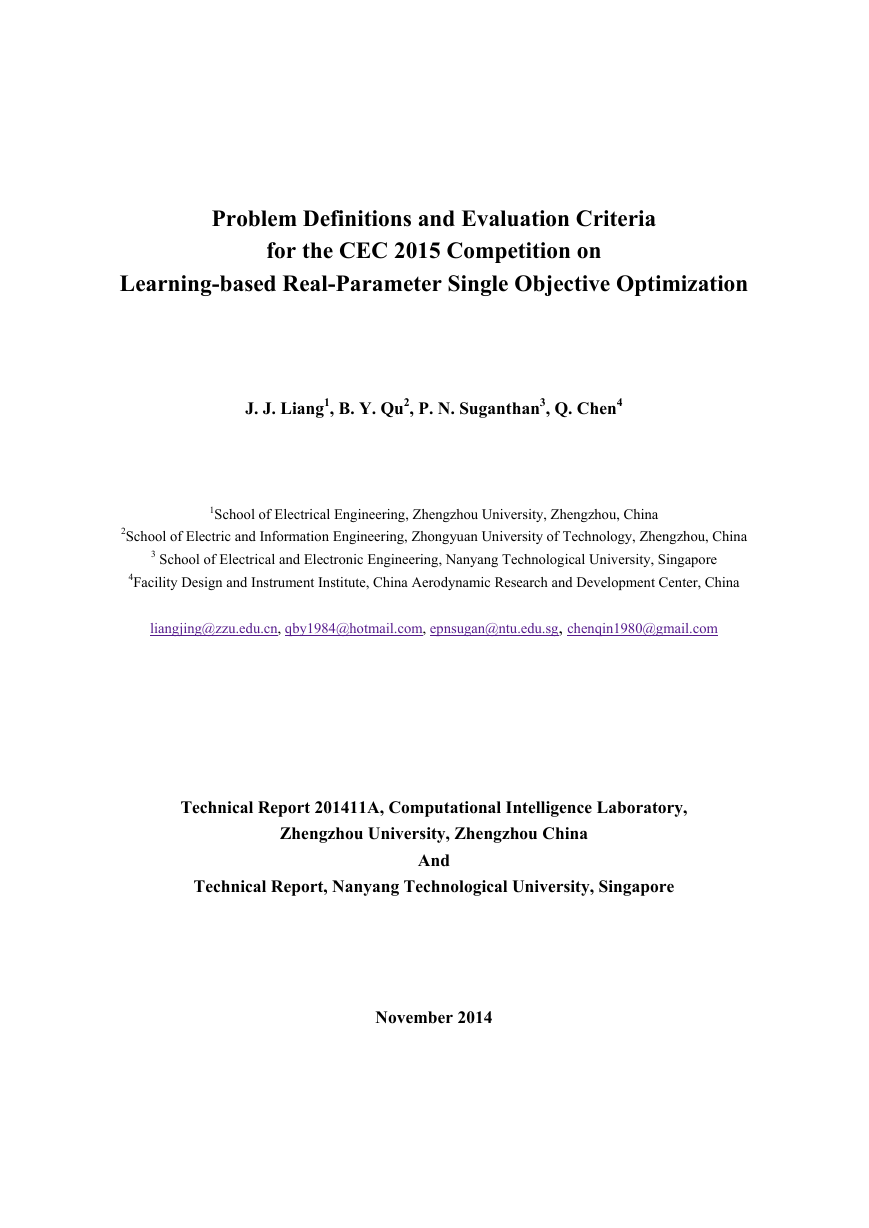
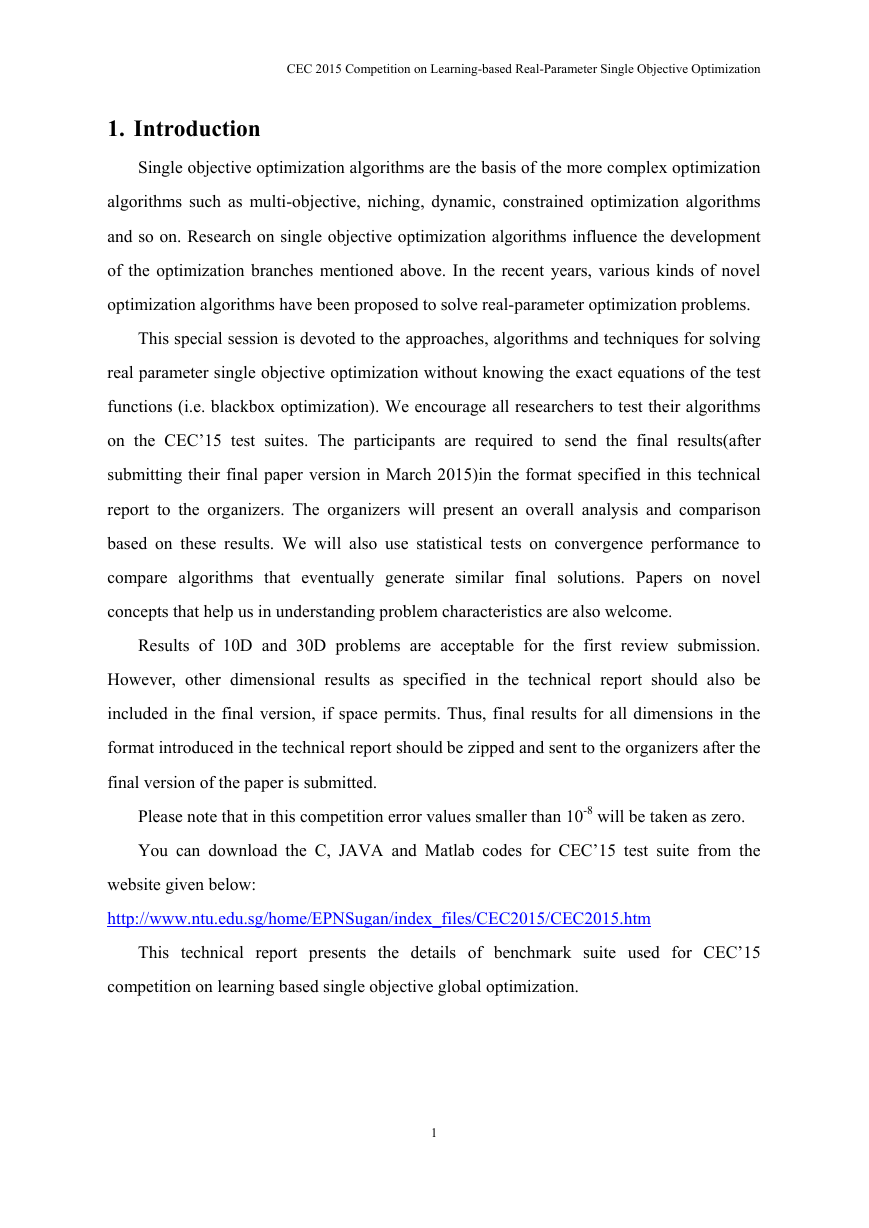
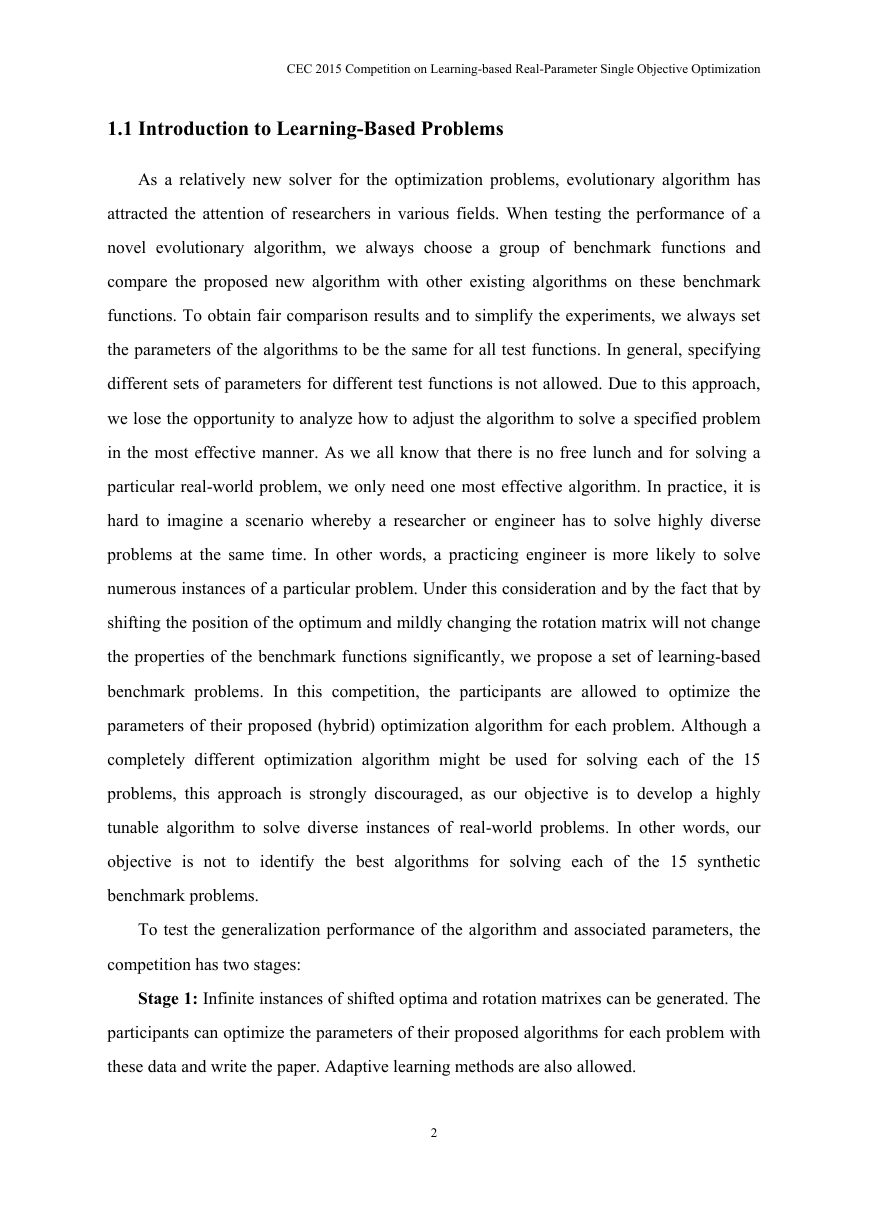
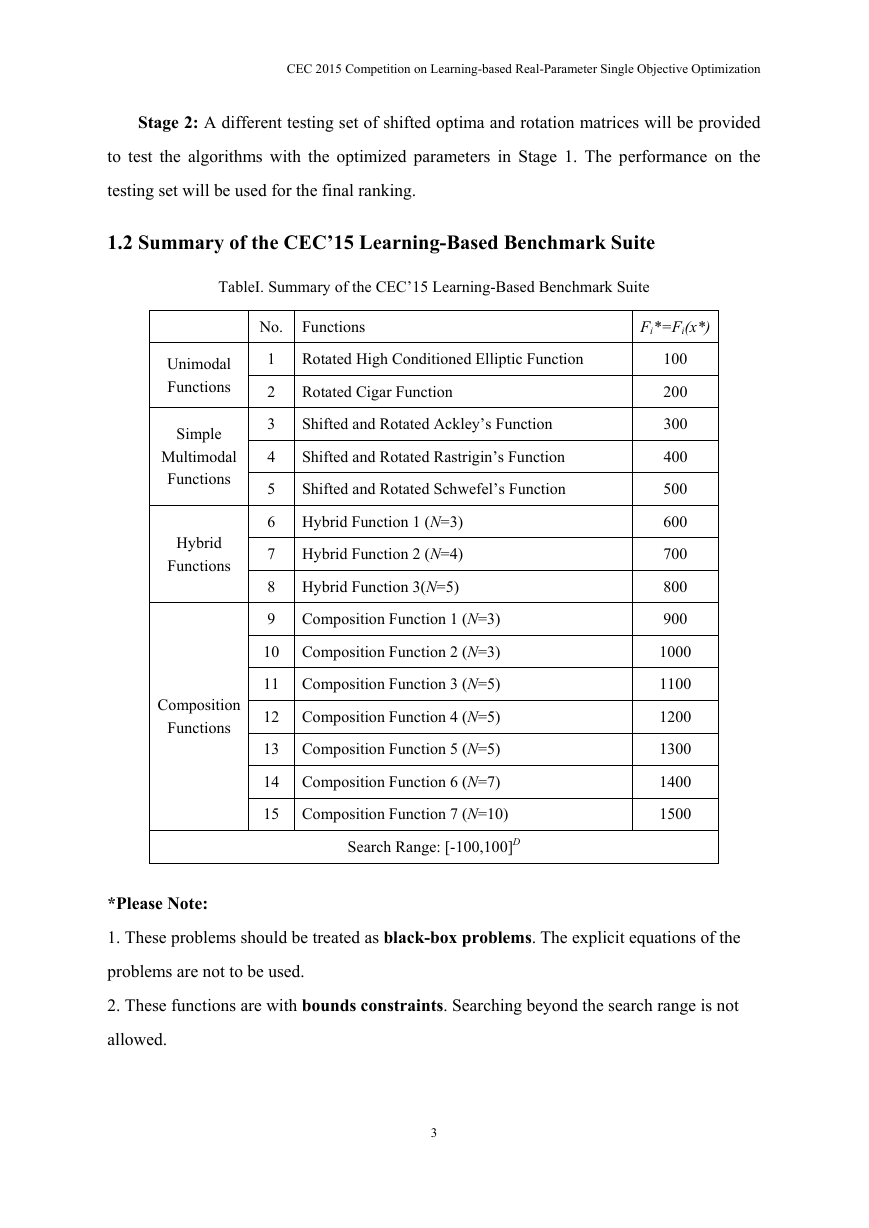
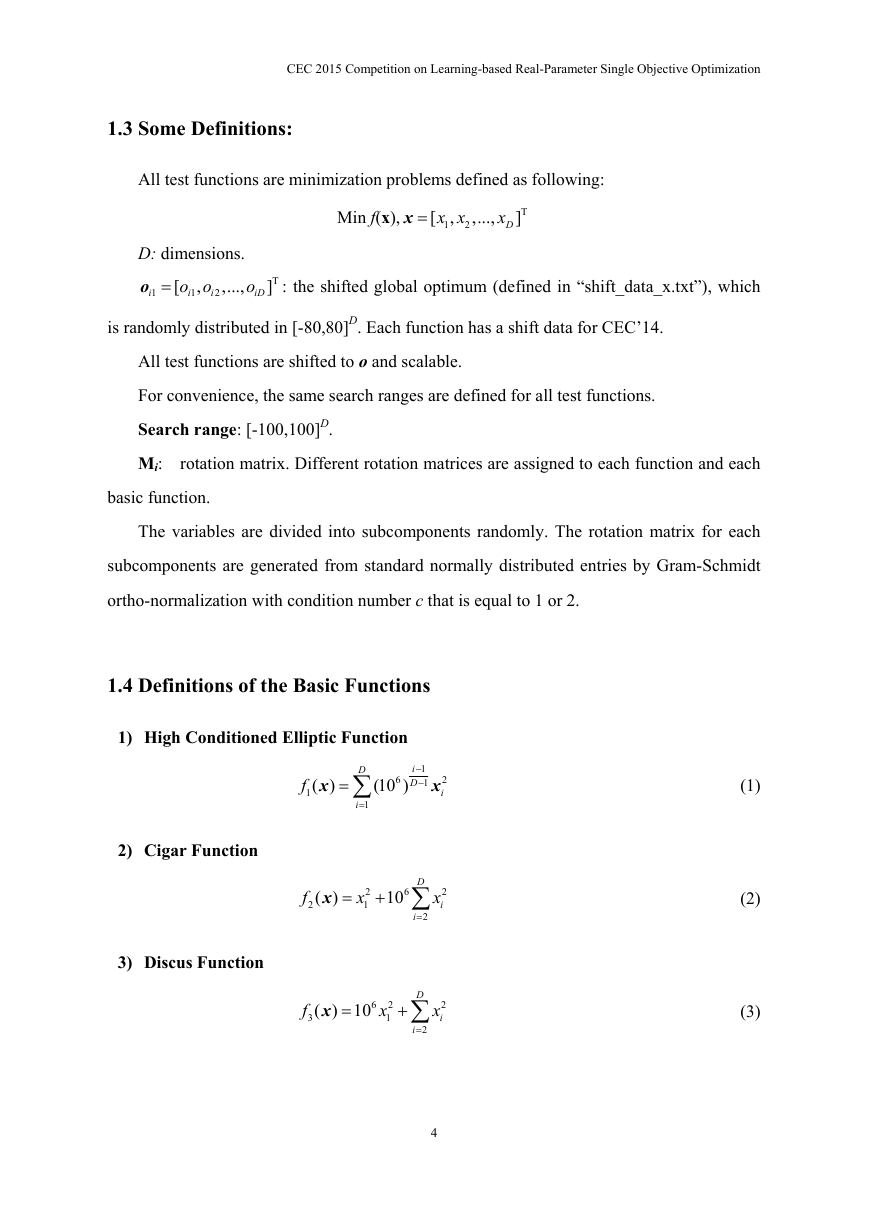
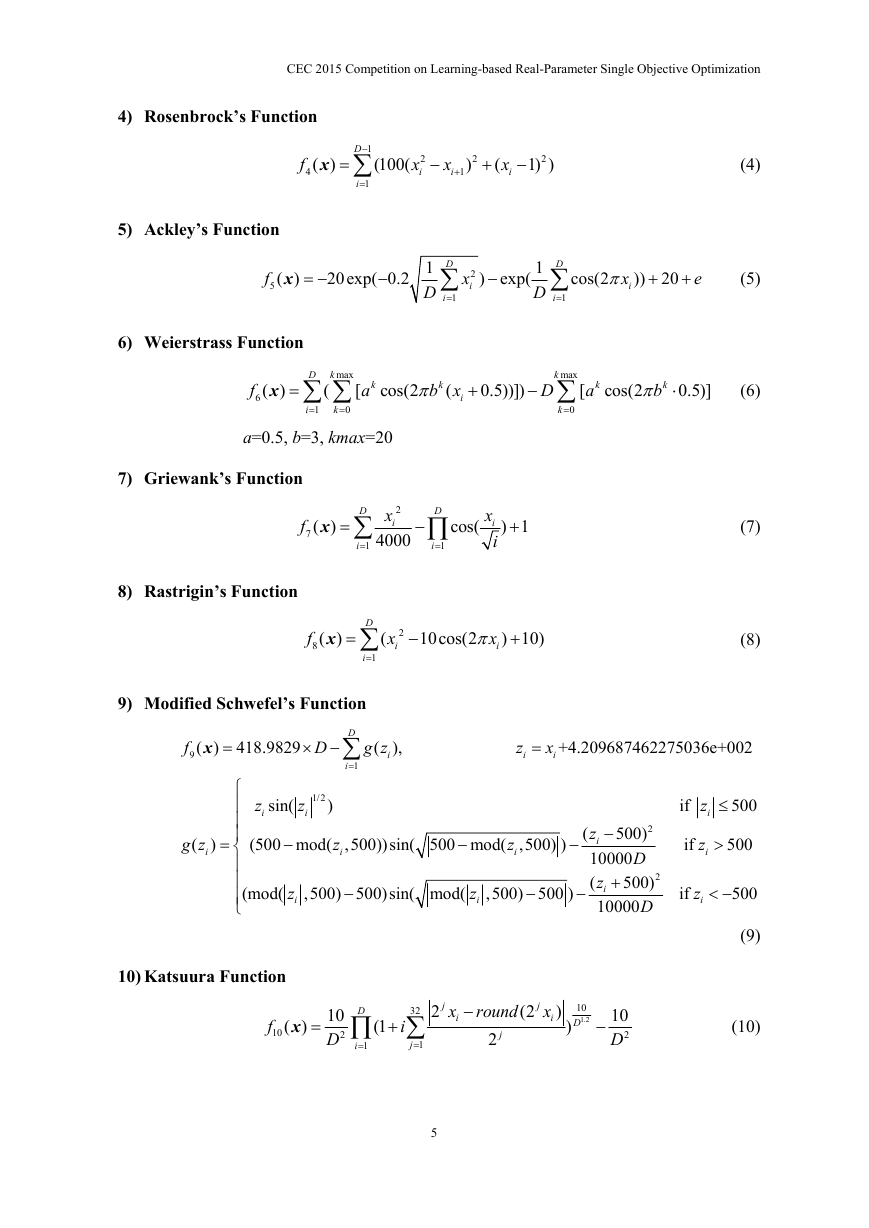
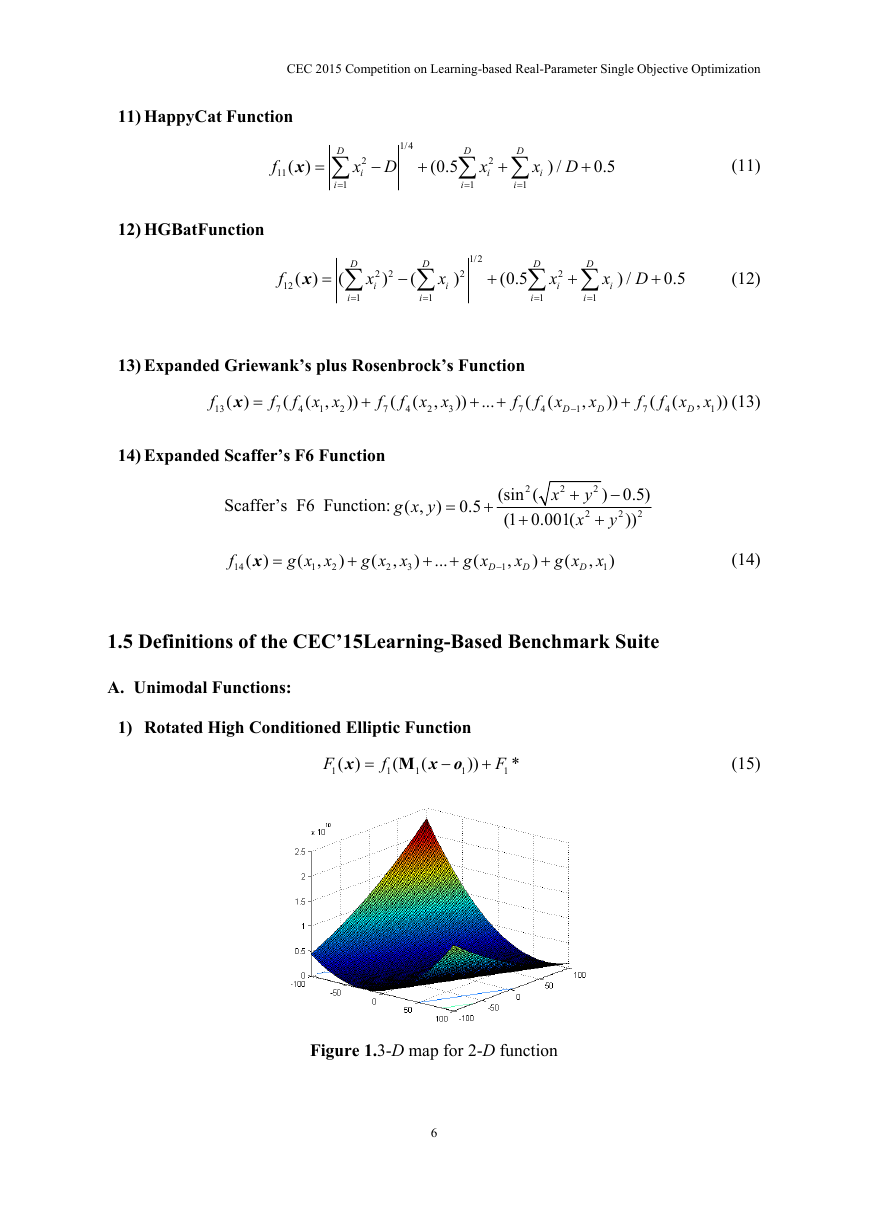
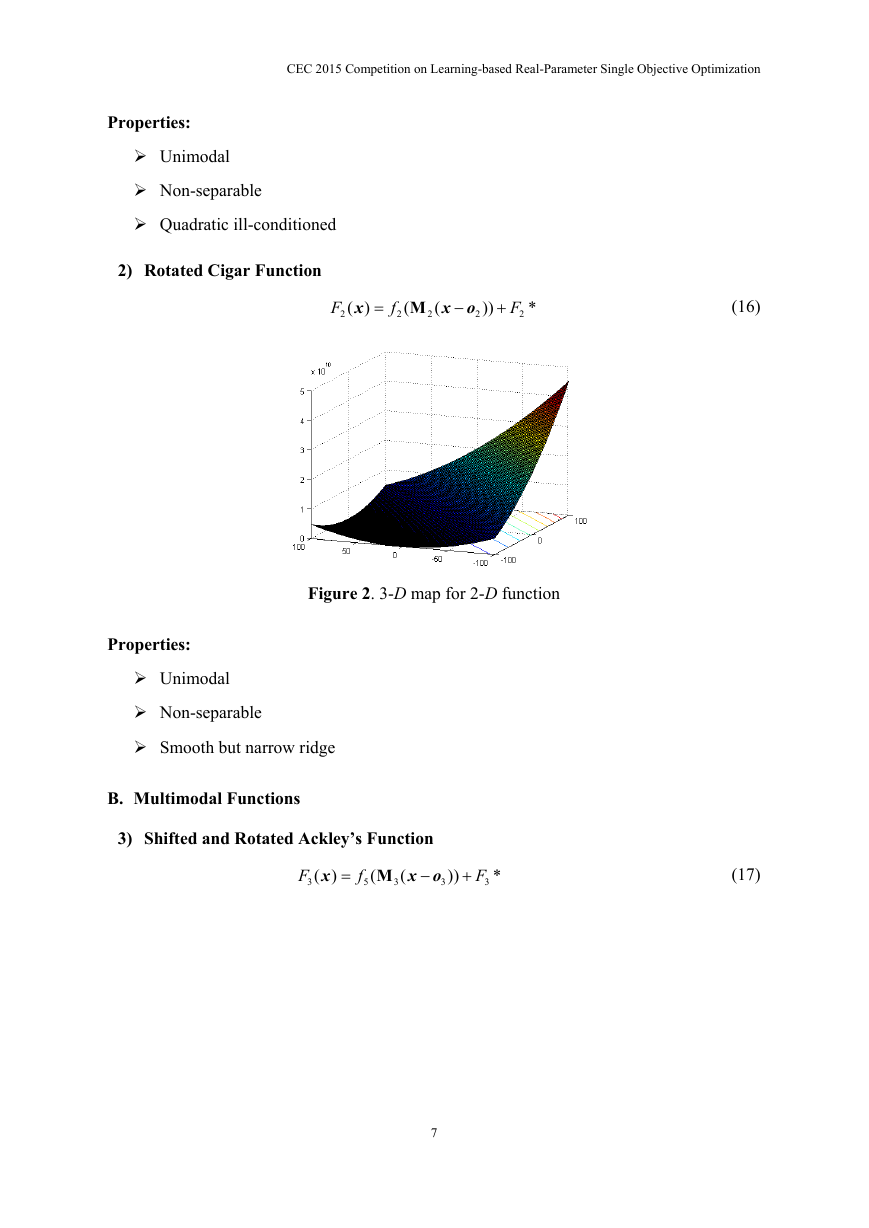








 2023年江西萍乡中考道德与法治真题及答案.doc
2023年江西萍乡中考道德与法治真题及答案.doc 2012年重庆南川中考生物真题及答案.doc
2012年重庆南川中考生物真题及答案.doc 2013年江西师范大学地理学综合及文艺理论基础考研真题.doc
2013年江西师范大学地理学综合及文艺理论基础考研真题.doc 2020年四川甘孜小升初语文真题及答案I卷.doc
2020年四川甘孜小升初语文真题及答案I卷.doc 2020年注册岩土工程师专业基础考试真题及答案.doc
2020年注册岩土工程师专业基础考试真题及答案.doc 2023-2024学年福建省厦门市九年级上学期数学月考试题及答案.doc
2023-2024学年福建省厦门市九年级上学期数学月考试题及答案.doc 2021-2022学年辽宁省沈阳市大东区九年级上学期语文期末试题及答案.doc
2021-2022学年辽宁省沈阳市大东区九年级上学期语文期末试题及答案.doc 2022-2023学年北京东城区初三第一学期物理期末试卷及答案.doc
2022-2023学年北京东城区初三第一学期物理期末试卷及答案.doc 2018上半年江西教师资格初中地理学科知识与教学能力真题及答案.doc
2018上半年江西教师资格初中地理学科知识与教学能力真题及答案.doc 2012年河北国家公务员申论考试真题及答案-省级.doc
2012年河北国家公务员申论考试真题及答案-省级.doc 2020-2021学年江苏省扬州市江都区邵樊片九年级上学期数学第一次质量检测试题及答案.doc
2020-2021学年江苏省扬州市江都区邵樊片九年级上学期数学第一次质量检测试题及答案.doc 2022下半年黑龙江教师资格证中学综合素质真题及答案.doc
2022下半年黑龙江教师资格证中学综合素质真题及答案.doc